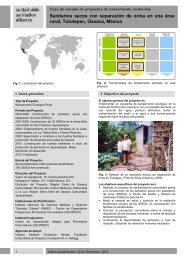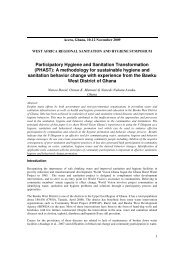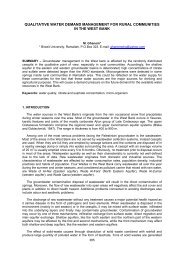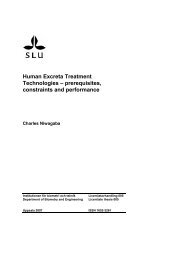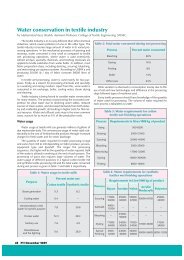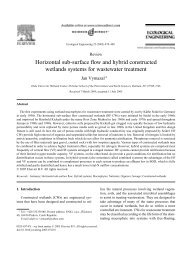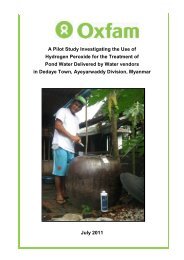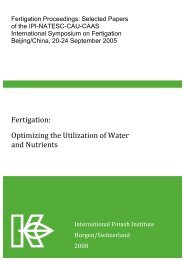Compilation of 13 factsheets on key sustainable sanitation ... - SSWM
Compilation of 13 factsheets on key sustainable sanitation ... - SSWM
Compilation of 13 factsheets on key sustainable sanitation ... - SSWM
You also want an ePaper? Increase the reach of your titles
YUMPU automatically turns print PDFs into web optimized ePapers that Google loves.
can still functi<strong>on</strong> during flooding events. UDDTs are<br />
potentially resilient to all expected negative climate change<br />
impacts while water born systems (flush toilets and sewers)<br />
are more vulnerable to different climate change scenarios<br />
(WHO and DFID 2009) 3<br />
.<br />
2.2 Greenhouse effect and c<strong>on</strong>tributing gases<br />
The greenhouse effect is the phenomen<strong>on</strong> where the<br />
presence <str<strong>on</strong>g>of</str<strong>on</strong>g> so-called greenhouse gases (GHG) cause<br />
warming <str<strong>on</strong>g>of</str<strong>on</strong>g> the earth's surface: GHG allow solar radiati<strong>on</strong> to<br />
enter the earth's atmosphere but prevent heat from<br />
escaping back out to space. They absorb infrared radiati<strong>on</strong><br />
and reflect it back to the earth's surface leading to its<br />
warming.<br />
Many human activities cause GHG emissi<strong>on</strong>s which drive<br />
the anthropogenic greenhouse effect. According to the<br />
Intergovernmental Panel <strong>on</strong> Climate Change (IPCC) the<br />
anthropogenic greenhouse effect will cause a rise in the<br />
mean global temperature <str<strong>on</strong>g>of</str<strong>on</strong>g> between 1.1 and 6.4°C by the<br />
end <str<strong>on</strong>g>of</str<strong>on</strong>g> the 21 st century (IPCC, 2007a). Changes in rainfall<br />
patterns, rising sea level and weakening <str<strong>on</strong>g>of</str<strong>on</strong>g> sea currents will<br />
also have additi<strong>on</strong>al impacts <strong>on</strong> the global temperature<br />
distributi<strong>on</strong>. In order to limit climate change to tolerable<br />
levels, global temperature rise should be limited to 2°C<br />
(IPCC, 2007b). To achieve this, GHG emissi<strong>on</strong>s would have<br />
to be reduced by 50% by 2050 compared to the level in<br />
1990 (IPCC, 2007c).<br />
2.3 Relevant greenhouse gases<br />
In the field <str<strong>on</strong>g>of</str<strong>on</strong>g> sanitati<strong>on</strong>, the following GHG are climate<br />
relevant:<br />
• Methane (CH4) is a potent greenhouse gas with a global<br />
warming potential 25 times higher than that <str<strong>on</strong>g>of</str<strong>on</strong>g> carb<strong>on</strong><br />
dioxide (CO2) in a 100 year perspective (IPCC/TEAP,<br />
2005). In anaerobic processes, organic matter c<strong>on</strong>tained<br />
in domestic waste and wastewater is decomposed and<br />
biogas is formed which c<strong>on</strong>tains 60-70% methane.<br />
In soak pits, anaerobic p<strong>on</strong>ds, septic tanks and other<br />
anaerobic treatment systems or even at the discharge <str<strong>on</strong>g>of</str<strong>on</strong>g><br />
untreated wastewater into water bodies, anaerobic<br />
processes take place to different extents and methane is<br />
released to the atmosphere.<br />
While combusti<strong>on</strong> <str<strong>on</strong>g>of</str<strong>on</strong>g> biogas produces CO2, a<br />
•<br />
greenhouse gas (see below), the carb<strong>on</strong> in biogas<br />
comes from solid or liquid biomass that has fixed carb<strong>on</strong><br />
from atmospheric CO2. Thus, biogas usage is carb<strong>on</strong>neutral<br />
and does not add to greenhouse gas emissi<strong>on</strong>s.<br />
Carb<strong>on</strong> dioxide (CO2) is produced as a result <str<strong>on</strong>g>of</str<strong>on</strong>g><br />
combusti<strong>on</strong> <str<strong>on</strong>g>of</str<strong>on</strong>g> any fossil or biomass fuel. However, CO2<br />
from biomass combusti<strong>on</strong> does not c<strong>on</strong>tribute to global<br />
warming as it originates from the atmosphere; it is a step<br />
in the organic carb<strong>on</strong> cycle. In sanitati<strong>on</strong>, CO2 emissi<strong>on</strong>s<br />
occur whenever fossil energy is used, as fossil fuelbased<br />
electricity. The treatment <str<strong>on</strong>g>of</str<strong>on</strong>g> wastewater for<br />
removal <str<strong>on</strong>g>of</str<strong>on</strong>g> organic matter and nutrients in wastewater<br />
treatment plants requires energy. The same holds true<br />
for the producti<strong>on</strong> <str<strong>on</strong>g>of</str<strong>on</strong>g> mineral fertilisers which is a very<br />
energy intensive process.<br />
• Nitrous oxide (N2O) is a str<strong>on</strong>g greenhouse gas with a<br />
3 WSSCC working group <strong>on</strong> WASH and climate change<br />
www.wsscc.org/topics/hot-topics/climate-change-and-wash<br />
global warming potential 298 times higher than that <str<strong>on</strong>g>of</str<strong>on</strong>g><br />
CO2 in a 100 year perspective (IPCC/TEAP, 2005).<br />
Nitrous oxide emissi<strong>on</strong>s occur during the denitrificati<strong>on</strong><br />
process in wastewater treatment, at the disposal <str<strong>on</strong>g>of</str<strong>on</strong>g><br />
nitrogenous wastewater into aquatic systems and also<br />
during mineral nitrogen fertiliser producti<strong>on</strong>. For climate<br />
protecti<strong>on</strong>, nitrogen in excreta or wastewater can be<br />
recovered and reused as a fertiliser to save energy.<br />
3 Climate change mitigati<strong>on</strong> and adapti<strong>on</strong><br />
potential <str<strong>on</strong>g>of</str<strong>on</strong>g> sanitati<strong>on</strong><br />
3.1 Mitigati<strong>on</strong> measures<br />
3.1.1 Energy recovery<br />
Sanitati<strong>on</strong> systems can be designed and operated to<br />
produce renewable energy in the forms <str<strong>on</strong>g>of</str<strong>on</strong>g> either biogas or<br />
biomass and thus reduce primary energy c<strong>on</strong>sumpti<strong>on</strong> (see<br />
Secti<strong>on</strong> 4 for details). Small scale biogas systems can<br />
generate enough biogas to cook main family meals and thus<br />
replace part <str<strong>on</strong>g>of</str<strong>on</strong>g> the traditi<strong>on</strong>al used cooking fuels. It should,<br />
however, be kept in mind that particularly in small systems<br />
the organic load from human excreta al<strong>on</strong>e is in most cases<br />
not high enough for the ec<strong>on</strong>omical usage <str<strong>on</strong>g>of</str<strong>on</strong>g> biogas for<br />
cooking, lighting or heating but still beneficial. Much more<br />
biogas is produced if animal excreta, organic solid waste<br />
(e.g. from kitchens and/or markets), or agricultural waste is<br />
co-digested as well.<br />
Figure 2: Biogas stove at Cachoire Girls High school, Kiambu,<br />
Kagwe District, Kenya (source: S. Blume, 2009). More photos about<br />
this project: www.flickr.com/photos/gtzecosan/collecti<strong>on</strong>s<br />
/72157616752316076<br />
Biogas can also be used for combined heat and electricity<br />
generati<strong>on</strong> by means <str<strong>on</strong>g>of</str<strong>on</strong>g> a combined heat and power (CHP)<br />
plant. This can substitute the use <str<strong>on</strong>g>of</str<strong>on</strong>g> fossil or n<strong>on</strong>-renewable<br />
energy sources.<br />
Another possible energy recovery method is the recovery <str<strong>on</strong>g>of</str<strong>on</strong>g><br />
heat from wastewater especially in cold countries where the<br />
wastewater temperature is higher than the ambient<br />
temperature. Warm greywater from showers, wash basins<br />
and sinks (with temperatures <str<strong>on</strong>g>of</str<strong>on</strong>g> up to 35°C) usually flows<br />
directly into the sewage system. The energy c<strong>on</strong>tained in<br />
the greywater can however be effectively recovered by<br />
means <str<strong>on</strong>g>of</str<strong>on</strong>g> heat exchangers installed inside or close to the<br />
house. C<strong>on</strong>versely, most <str<strong>on</strong>g>of</str<strong>on</strong>g> the thermal energy in the<br />
wastewater is lost in the sewer. Depending <strong>on</strong> climate,<br />
Renewable energies and climate change: Working Group 3 - page 2



